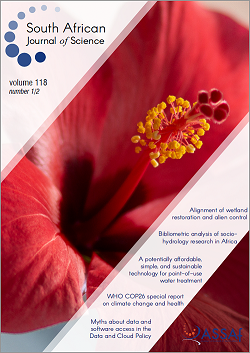The use of Z-scores to facilitate morphometric comparisons between African Plio-Pleistocene hominin fossils: An example of method
DOI:
https://doi.org/10.17159/sajs.2022/11182Keywords:
morphometrics, hominin, Plio-Pleistocene, Australopithecus, Homo habilisAbstract
South Africa and East Africa each have a rich palaeoanthropological heritage, but the taxonomy of fossil hominins from these regions is controversial. In this study, two morphometric methods related to the quantification of variability in morphology have been applied to pairwise comparisons of linear measurements of hominoid crania and mandibles. The log-transformed standard error of the m-coefficient (‘log sem’) is calculated from linear regressions. Like Procrustes Distances (PD), log sem statistics can serve to quantify variation in the shape of a cranium or mandible in the context of a constellation of landmarks. In this study, PD and log sem statistics are integrated and standardised using Z-scores, and applied probabilistically to Plio-Pleistocene hominins. As a test case, OH 7 and OH 24 as reference specimens of Homo habilis are compared to fossils representing other taxa. There is a wide spectrum of variation in Z-scores for specimens attributed to early Homo dated within the period between circa 1.8 Ma and 2 Ma. In terms of morphometric variation predating 1.8 Ma, Z-scores (Z<2) for Australopithecus afarensis, A. africanus and Homo habilis display a small range of variability. This study serves as a demonstration of a method whereby log sem and PD can be used together to facilitate an objective assessment of morphological variability, applicable in palaeontological contexts.
Significance:
- Using a probabilistic approach, two morphometric methods are integrated to quantify morphological variability in Plio-Pleistocene African hominin mandibles and crania.
- Two Tanzanian specimens of Homo habilis (the OH 7 mandible of the holotype specimen, and the OH 24 skull) can be used as reference material for morphometric comparisons with other fossils (mandibles or crania) attributed to Australopithecus africanus, A. afarensis, H. erectus and H. rudolfensis.
- The results of these comparisons are expressed as standardised probabilistic Z-scores such that these statistics for skulls and mandibles can be expressed on a common scale.
Published
Issue
Section
License

All articles are published under a Creative Commons Attribution 4.0 International Licence
Copyright is retained by the authors. Readers are welcome to reproduce, share and adapt the content without permission provided the source is attributed.
Disclaimer: The publisher and editors accept no responsibility for statements made by the authors
How to Cite
- Abstract 720
- PDF 849
- EPUB 515
- XML 605












.png)